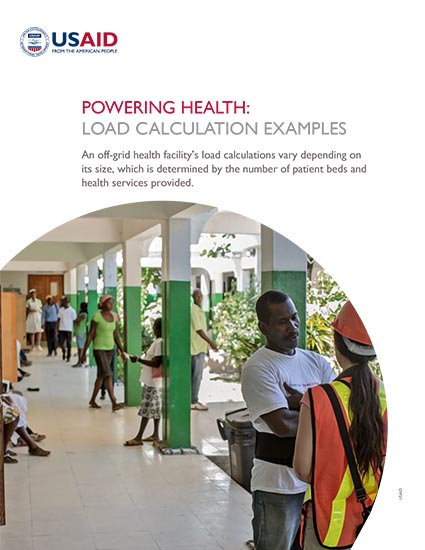An off-grid health facility’s load calculations vary depending on its size, which is determined by the number of patient beds and health services provided.
An initial load and energy analysis of an off-grid health facility is critical to facilitate the design and operation of energy supply systems. When properly executed, a load analysis can yield valuable insights into facility energy usage that can help reduce energy costs, increase productivity, and protect critical assets.
Off-grid health clinics are key to providing health-care services to people in surrounding villages. To provide effective health care, it is necessary to have a power infrastructure that is adequate for the types of health services provided. For example, small off-grid health clinics offer limited health services, such as outdoor-patient (OPD) consultations, administering vaccinations, and performing simple surgical procedures such as suturing. Slightly larger off-grid health clinics may offer additional services, such as childbirth, neonatal, and dental care. Different equipment (centrifuge, vaccine refrigerator, microscope, dental chair, etc.) is required, and its energy consumption and source of power supply must be considered in the planning process.
Small Off-Grid Health Clinic
Small off-grid health clinics are typically located in remote villages and offer basic health-care services.
Medium Off-Grid Health Clinic
Medium off-grid health clinics offer a variety of health services. In selecting proper power supply sources, such as a solar power system, the operating characteristics of the power equipment must be considered.
Large Off-Grid Health Clinic
A large off-grid health clinic has capacity in excess of 120 beds and typically offers the expanded health services of a medium off-grid health clinic, as well as basic laboratory facilities.
Additional Resources
-
Load Calculation and System Optimization
This exclusive online version of the HOMER Powering Health Tool evaluates hybrid power systems to determine the most cost-effective options for delivering continuous electricity to health facilities. Use the tool
-
USAID
Analyze Energy Demand and Supply
Before investing in any energy technologies, a health facility must first understand its current day-to-day energy requirements. An initial energy audit is critical to ensuring proper system design and operation. Learn more
-
USAID
Cold Chain and Refrigeration
A cold chain is a series of climate-controlled transport and storage facilities that ensure the viability of testing reagents, medicines, vaccines, and blood products from factory to patient. Learn more
-
Thavlosk (CC BY-SA 3.0)
Efficient Lighting and LEDs
Health facilities of all sizes can benefit from lighting that increases energy efficiency, reduces maintenance costs, and improves environments. Learn more
-
USAID
Batteries and Battery Management
Batteries provide backup power during gaps in electricity generation. They are critical for some energy systems but are expensive and may require maintenance or replacement. Learn more
-
DaoPhiNtech (CC BY-SA 4.0)
Uninterruptible Power Supplies
Uninterruptible power supplies provide backup power, protecting equipment from damage in the event of grid power failure. Learn more


Comment
Make a general inquiry or suggest an improvement.